A Tribute to Ron Majors
LCGC North America
For more than 40 years, he has been a master communicator. That's just one reason he has so many fans, and friends, around the world.
From making major advances in column technology to educating several generations of chromatographers, Ron Majors has played an invaluable role in the field of separation science.
In any scientific field, it is important to honor our heroes. In the separation science community, we do that in various ways. Yet we sometimes overlook the vital contributions of leading scientists at analytical instrumentation companies, whose achievements are often different from those of scientists in academia. It is that sentiment that drove the idea for this special tribute to longtime LCGC columnist and editorial advisory board member Ronald E. Majors.
Majors has spent almost his entire career in analytical instrumentation, with 16 years at Varian Associates, 3 at EM Science (now EMD Millipore), and 23 at what was originally Hewlett-Packard (HP) and which later became Agilent Technologies. In that work, he has made critical scientific advances, and also educated generations of chromatographers around the globe, by working directly with customers and giving scientific talks.
But for many, of course, it is for his work beyond his day job that Majors is best known, and so greatly admired: his monthly columns here in LCGC, columns that he has been writing for more than 30 years.
At the HPLC 2013 conference in Amsterdam this June, the editors of LCGC and Peter Schoenmakers, the conference chair, will present Majors with a special award of appreciation for all of his contributions to the separation science community.
In this tribute, colleagues and friends from around the world discuss what Ron Majors has meant to the field of separation science, and why the scientific community — and the LCGC community in particular — appreciates him so much.
Early Achievements
Majors began making an impression on those around him from the very beginning of his scientific career.
Stuart Cram, vice president of Strategic Consulting International in Danville, California, remembers meeting Majors when they were both in graduate school. Cram took a trip from the University of Illinois, where he was studying, to Purdue University in Indiana, where Majors was completing his doctorate under Professor L.B. "Buck" Rogers.
"During that visit, I could see that Ron was bound to set a high standard in chromatography, because he radiated an exceptional personality and excellence in chromatography research," said Cram. "He was clearly dedicated to making a significant contribution to the field of chromatography, starting in the early 1960s."
After Majors completed his doctorate, with a thesis on the synthesis and characterization of very selective adsorbents (molecular imprinted phases) for liquid chromatography (LC) and sample preparation, he did an initial stint in industry, in the separations laboratory at Celanese, in Summit, New Jersey. He then made his definitive move into analytical instrumentation, starting with Varian Associates in Walnut Creek, California, in 1971.
In Varian's research and development division, Majors and Cram met up again and became colleagues, sealing a friendship that continues today. Cram has fond memories of that time, when Majors worked on high performance liquid chromatography (HPLC) columns and chemistry and Cram specialized in gas chromatography (GC) instrumentation and automation. "I learned more about HPLC in those days through Ron than anything I could have learned from symposia and published papers," he said. "Ron distinguished himself in HPLC column technology, was exceptionally focused and innovative, and was totally supportive of the manufacturing department as they began making small-particle HPLC columns," he continued.
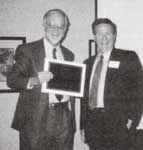
Figure 1: Bill Hancock (left) presenting the 1998 CASSS award to Ron Majors.
Pat Sandra, professor emeritus at Ghent University in Belgium, remembers the team of Majors and Cram well. "Once upon a time, in the 1970s, there were two very important separation scientists at Varian in Walnut Creek: Stuart Cram for GC and Ron Majors for LC," said Sandra. "My boss at that time, Professor Maurits Verzele, was a consultant for Varian, and I was often invited to join the meetings. I was impressed by the technical achievements they made."
Groundbreaking Advances in LC Column Technology
Majors was indeed making impressive achievements. When we asked other separation scientists what they consider Ron Majors's greatest contribution to the field, his groundbreaking work in HPLC columns was cited repeatedly.
"Ron was one of the first people to study and optimize silica particles and bonding chemistry," said Dick Henry, an analytical consultant who has known Majors since they shared a laboratory at Purdue, when Majors was a graduate student and Henry was a post-doc.
Sjoerd van der Wal, a former Varian colleague who is now retired from DSM and still a part-time professor at the University of Amsterdam, summarized Majors's contribution to column science succinctly.
"He packed the first real HPLC column," he said.
Majors described that column packing in a 1972 paper in Analytical Chemistry (1). It was through that paper that Roy Eksteen, currently a market segment manager at Sigma-Aldrich/Supelco, first "met" Majors. The manuscript, as Eksteen remembers well, introduced the concept of using a balanced density slurry solvent to prevent settling of the particles during column packing. The solvent consisted of tetrabromoethane (60.6 wt %) and tetrachloroethylene (39.4 wt %), a composition that was carefully "adjusted by observing the direction the silica particles tended to migrate in the vial when left undisturbed for a period of 30 minutes and adding either tetrabromomethane or tetrachloroethylene to resuspend them."
The packing of that 150 mm × 2.1 mm stainless steel column also advanced another important new approach: performing column packing at a pressure of 5000 psi (340 bar, 34 MPa). "This is not too different from what became standard practice in the industry several years later, and is a procedure that has not been changed much since then," notes Eksteen.
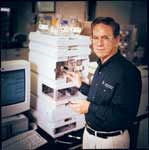
Figure 2: Ron Majors in the laboratory at Agilent, in the early 2000s.
The particles Majors packed into that column were also very small — 5–10 µm in diameter — and this was another important advance in fundamental concepts of HPLC.
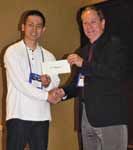
Figure 3: Majors presenting the Best Poster Award to Kanta Horie of the Kyoto Institute of Technology of Kyoto, Japan, at the HPLC 2006 conference in San Francisco.
"The standard particles at that time were 37–44 µm, so the move to 10 µm was a game changer," said John Dolan of LC Resources, himself a prominent expert in HPLC and the longtime author of the "LC Troubleshooting" column in LCGC.
"The columns Ron packed proved the point that smaller particles resulted in more-efficient and faster separations," points out Eksteen."That was very much at the start of the pioneering days of HPLC."
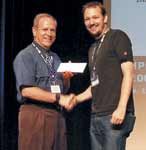
Figure 4: Majors presenting the Best Poster Award to Wolfgang Weider of the University of Innsbruck, Austria, at the HPLC 2007 conference in Ghent, Belgium.
Lloyd Snyder, now retired from LC Resources, concurs. "This 1972 publication on small-particle columns was a major contribution to the field of separation science," he said.
"Ron was one of the early trend setters in HPLC, a role that he continued to play throughout the next 40 years of his illustrious career," concluded Eksteen.
Educating Others
Majors's contribution to separation science is not limited to his groundbreaking advances in column development, however. In fact, Ron Majors is perhaps more famous for his work explaining separation science to others.
"Ron has a sustained passion for HPLC column technology, and an outstanding record of educating others, through hundreds of seminars, short courses, published papers, and columns in LCGC," said Cram. "Thanks to his exceptional contributions sharing his knowledge and technical expertise, people using HPLC in every country in the world know the name of Ron Majors."
Indeed, an important aspect of Majors's work at Agilent is providing technical advice to staff and customers worldwide about columns and sample preparation. To do this, he travels extensively around the world, working with customers, giving seminars at customer sites and in Agilent-sponsored events, and presenting technical papers at national and international meetings.
"I suspect that no one has given more talks on LC, solid-phase extraction, and sample preparation — or logged more miles around the world — than Ron," said Henry.
Maria Matyska-Pesek, an adjunct professor at San Jose State University, noted the popularity of those presentations. "Ron's lectures on HPLC columns, techniques, and tips have always generated large audiences," she said.
Of course, the reason his talks are popular is because they are so good. "Ron has a remarkable ability to teach the complicated matters of running HPLC columns and systems in a clear way on a level that novices can understand," said Gerard Rozing, a retired Agilent research fellow. "The practical detail that he includes is convincing because of his broad competence."
Of course, the podium is just one forum Majors uses for teaching. He is renowned worldwide for his work educating separation scientists through his regular columns in LCGC.
Majors started writing monthly for LCGC in 1983, in the second issue, when the magazine was called just LC. For the first seven years, he wrote just about columns — mainly about LC columns but also about gas chromatography (GC) columns. After joining HP (Agilent) in 1990 and starting to work in sample preparation, Majors launched a second column, "Sample Preparation Perspectives," in January 1991. He continues both columns to this day, 30 years later.
"As a columnist in LCGC, he's become known worldwide as the go-to guy for information on column technology and sample prep for HPLC," says fellow LCGC columnist Dolan.
"Ron has enormous knowledge about LC, and about LC columns in particular, combined with an unrivaled ability to bring this across to regular LC users," said Peter Schoenmakers, a chemistry professor at the University of Amsterdam. "Ron has raised the competence level of several generations of LC users."
"His communication skills are impressive," agrees Sandra. "In the long term, I think he will receive most credit for his LCGC column contributions on LC and sample preparation."
Majors's work educating LCGC's readers goes beyond his monthly column. He has served as guest editor for many LCGC special issues, on topics such as LC column technology, sample preparation, and more recently, ion chromatography. He has also authored or coauthored many wall charts, and designed numerous surveys and analyzed the results for readers.
In all his writing for LCGC, Majors has shown an incredible ability not just to explain the fundamentals of chromatography columns and sample preparation, but also to keep readers abreast of the latest developments in technologies and methods. He always has his finger on the pulse of what is new, and then explains it to readers in practical terms, so that they know which concepts are just exciting theories or early-stage developments and which ones are proven approaches they should consider applying in their own laboratories.
At a recent meeting of the editorial advisory board of LCGC, time after time, after someone proposed an idea for coverage, one of us would say "Ron just covered that," or "Ron just invited that person to write a guest column," or "Ron just brought that expert in as a contributor to our recent special issue on that topic." He always knows what is going on and who can explain it best — on the odd occasion when that person is not himself!
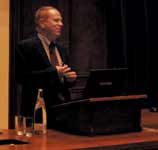
Figure 5: Majors speaking at 2011 Desty Memorial Lecture at the Royal Institution of Great Britain.
Majors also has applied his ability to encapsulate new chromatography developments to his annual Pittcon review articles in LCGC, which started with his second installment of his "Column Watch" column, in May 1983. In those Pittcon reviews, Majors not only manages to identify all the new chromatography columns and sample preparation instruments introduced at the conference; he also explains the significance of these developments and analyzes the trends.
"This regular Pittcon article became the standard reference describing the latest developments in LC columns," said Henry.
Awards
Given all his accomplishments, it is not surprising that Majors has received important awards over the years. He was the recipient of the 1994 Merit Award in Chromatography from the Chicago Discussion Group, the 1998 Award for Distinguished Contributions in Separation Science sponsored by CASSS (formerly known as the California Separations Science Society), and, in 2000, the "Salute to Excellence" Award from the North Jersey Chromatography Discussion Group. He also received the 2006 Palmer Award from the Minnesota Chromatography Forum and, most recently, the Chromatographic Society's 2007 Martin Gold Medal from the United Kingdom, named for the Nobel Prize winner A.J.P. Martin.
Other Service
In addition to fostering the development of chromatography and chromatographers worldwide through his scientific developments, teaching, and writing, Ron Majors has served the scientific community in other ways.
One of those has been his involvement with the HPLC conferences, where he was the poster committee chair from 1998 to 2008. "Ron was the mastermind behind the (first HP then) Agilent poster awards at the HPLC meetings, and I became his right-hand man," says Schoenmakers. "We worked closely together for quite a few years. Ron was incredibly committed to the task, and he did a fantastic job." Majors was also the chair of HPLC 1986, in San Francisco, California, an event that still ranks as the largest chromatography-only symposium ever held in terms of attendance.
Majors also has been highly involved in planning the annual spring symposium of the Chromatography Forum of the Delaware Valley and continues to serve on the Executive Committee. He was the program chair in 2007–2008 and president in 2008–2009. He also has been a member of the Associate Board of Directors of CASSS since 2011.
He also has served on the editorial advisory board of LCGC since its very first issue in March 1983. To this day, he continues to provide invaluable and constant support that goes far beyond conducting peer reviews, by regularly helping the editors with numerous and wide-ranging questions. And his answers are always clear, concise, and timely, no matter what part of the world he sends them from.
Pat Sandra put it succinctly. "Ron's selfless and endless commitment to the chromatographic community is unique and highly appreciated."
A Good Friend and Colleague
So many scientists in the field of separation science have warm recollections of Ron Majors, from hearing him talk, working with him in industry, collaborating on articles for LCGC, and more.
"One of my fondest memories of working with Ron was traveling with him to interesting places in the world to present HPLC and GC technology seminars," said Cram. "He was truly a scholar and highly respected by customers wherever we went. His communications style exemplified excellence in HPLC technology, and his presentations will never be forgotten."
Van der Wal recalls the kindness Majors showed him when van der Wal first came to Varian in 1982 for an interview, arriving on a flight that had been delayed several hours. His host, thinking van der Wal was not going to arrive that evening, had left the meeting area. "As I had no other contacts in California that I could reach at that time, I called Ron in the middle of the night," says van der Wal. "Although I hardly knew him, he helped me out and made sure my visit was arranged well." Van der Wal did swear, however, that he would avoid such post-midnight calls in the future. "I have kept that promise to this day!" he declares.
Matyska-Pesek reminisces about collaborating with Majors on the HPLC poster committee, and particularly about how he facilitated the work. "He was very well organized and made the process fair and seamless," she said. "Sometimes during the poster selection process we encountered opposite opinions about certain posters from two well known individuals. Ron was always able to come to the perfect solution, which was not easy in such situations."
Dolan shares a long history with Majors of writing columns for LCGC, and points out that Ron is the longest-active person in the LCGC publication, having started writing his column in the second issue. (Dolan started a few months later, in October 1983). "I don't believe there is anyone in the LCGC or Advanstar organization who is still around from those days," he says. "We joke that between us we break in all the new LCGC editors. He's been around for all of them, and I have been around for all but one."
Dick Henry shared a funny story, from an event many years ago where Majors was the keynote speaker. "It was early in the days of converting to PowerPoint with laptop computers and data projectors, and Ron was ahead of the game trying to use his laptop to project slides," said Henry. "A few slides into Ron's talk, we all were treated to the "Blue Screen of Death" which meant that his planned keynote talk was over." Henry was also on the program and recalls giving his talk while Majors quickly left and brought back a briefcase full of talks in older slide and transparency format. "He recovered quite well and was able to present the keynote talk that we all expected," says Henry. "Lots of things like that seem to happen to Ron, but he always lands on his feet."
A Passion for Life
Ron Majors's energy and commitment for his work is equally on display in his passion for life. He and his wife are avid birders and travel around the world to participate in their hobby, including to remote regions. Majors's "life list" — the tally that birding aficionados keep of all the species they have ever spotted — contains an incredible 3500 entries. He uses those birding trips to observe other forms of wildlife, too. During recent treks to Uganda and mountainous regions of northern India he has seen, and taken incredible photographs of, silverback gorillas and tigers, among others.
Knowing his busy work schedule and his vigorous wildlife trips, it is hard to remember — and in fact, most people don't realize — that Majors is over 70. Few can imagine keeping up with him.
And many don't know that Majors finds the time and energy to keep up with another significant hobby: stamp collecting. He is an expert in Canadian postal history and a member of the American Philatelic Society. He currently serves on the Board of Directors of the British North American Philatelic Society and is president-elect for 2014.
He also manages to find time to help out in his local community. He served as president of a local civic safety group, "Pennsbury Townwatch" in Pennsbury Township, Pennsylvania, from 2001 to 2004 and as the organization's publicity chair from 2004 to 2009.
Still Humble and Hardworking
Despite all of his accomplishments and his worldwide fame, Majors remains as humble, helpful, and hardworking as ever.
Mary Ellen McNally, a technical fellow at DuPont Crop Protection in Newark, Delaware, remembers hearing about Majors long before meeting him, because he was one of the first PhD students of L.B. Rogers, who was her post-doctoral research advisor. "Ron was somewhat of an enigma before I met him, like a rock star of chromatography," she said. "But over the years I have gotten to know him, and he is just a super nice man." In recent years, McNally has enjoyed working closely with Majors on the spring symposium program for the Chromatography Forum of the Delaware Valley.
"Ron is one of the most accessible scientists I have ever met," echoes van der Wal.
Dennis Blevins, a colleague at Agilent, agrees. "Ron is always willing to talk with all colleagues and continues to support the separation sciences, helping educate the next generation," he said. "Ron has always been a friend."
"I am sending Ron my warmest congratulations on his sustained quest for excellence, HPLC technology, and passion for supporting and educating the HPLC worldwide community," said Cram. "His outstanding career, through his attributes and contributions, has been accomplished through his passion for helping others throughout the world, and has made him a cornerstone of HPLC technologies for more than four decades."
References
(1) R.E. Majors, Anal. Chem. 44, 1722–1726 (1972).
Laura Bush is the editorial director of LCGC. Direct correspondence to lbush@advanstar.com
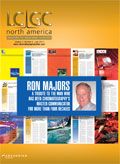
A Matrix-Matched Semiquantification Method for PFAS in AFFF-Contaminated Soil
Published: April 14th 2025 | Updated: April 14th 2025Catharina Capitain and Melanie Schüßler from the Faculty of Geosciences at the University of Tübingen, Tübingen, Germany describe a novel approach using matrix-matched semiquantification to investigate per- and polyfluoroalkyl substances (PFAS) in contaminated soil.
Silvia Radenkovic on Building Connections in the Scientific Community
April 11th 2025In the second part of our conversation with Silvia Radenkovic, she shares insights into her involvement in scientific organizations and offers advice for young scientists looking to engage more in scientific organizations.













